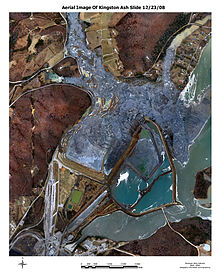
This is a list of notable waste disposal incidents.
| Incident | Description | Date | Location |
|---|---|---|---|
| Aberfan disaster | coal waste spill | 1966 | United Kingdom |
| Acerinox accident | radioactive contamination | 1998 | Spain |
| Agriculture Street Landfill | United States | ||
| Ajka alumina plant accident | caustic waste spill | 2010 | Hungary |
| Atari video game burial | 1983 | United States | |
| Bajzë Rail Station | chemical contamination | 1991 | Albania |
| Buffalo Creek Flood | coal slurry impound spill | 1972 | United States |
| Corby toxic waste case | United Kingdom | ||
| 2006 Côte d'Ivoire toxic waste dump | 2006 | Côte d'Ivoire | |
| Cuyahoga River | United States | ||
| Friendly Floatees | flotsam | 1992 | Ocean |
| Goiânia accident | radioactive contamination | 1987 | Brazil |
| Hansa Carrier | flotsam | 1990 | Ocean |
| Khian Sea waste disposal incident | 1986 | ||
| Kingston Fossil Plant coal fly ash slurry spill | coal fly ash slurry spill | 2008 | United States |
| 2015 Gold King Mine waste water spill | acid mine waste spill | 2015 | United States |
| Gold mine at Kingston, Queensland | toxic waste | Australia | |
| Lake Karachay | radioactive waste dump site | Russia | |
| Love Canal | toxic waste dump | United States | |
| Māpua contaminated site | toxic waste | 1932-88 | New Zealand |
| Martin County sludge spill | water pollution | 2000 | United States |
| Mayapuri | radioactive contamination | 1986 | India |
| McFarland incident | toxic waste | 2000 | South Korea |
| Minamata Bay mercury poisoning | cause of Minamata disease | 1932-68 | Japan |
| Mobro 4000 garbage barge | 1987 | United States | |
| Munisport | United States | ||
| Radioactive waste dumping by the 'Ndrangheta | radioactive waste | Italy | |
| Saint John, New Brunswick harbour cleanup | sewerage | Canada | |
| Seveso disaster | toxic pollutant | 1976 | Italy |
| Spodden Valley asbestos controversy | 2004 | United Kingdom | |
| Sydney Tar Ponds | hazardous waste | Canada | |
| Syringe Tide | 1987-88 | United States | |
| Techa River | radioactive contamination | Russia | |
| Teckomatorp | 1970s | Sweden | |
| Times Beach, Missouri | dioxin scare | 1983 | United States |
| Tonoshō, Kagawa | industrial waste dump | Japan | |
| Tui mine tailings dam | New Zealand | ||
| DuPont Washington Works | perfluorooctanoic acid dump | 1951-2003 | United States |
| Valley of the Drums | toxic waste dump | United States | |
| View-Master factory supply well | United States |